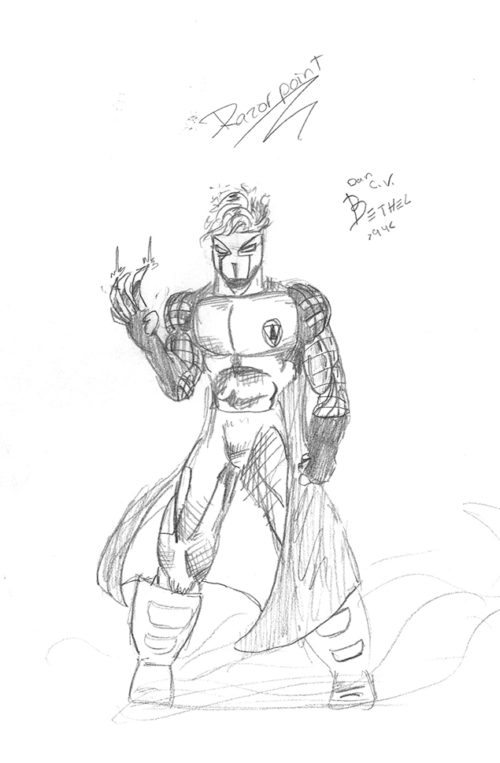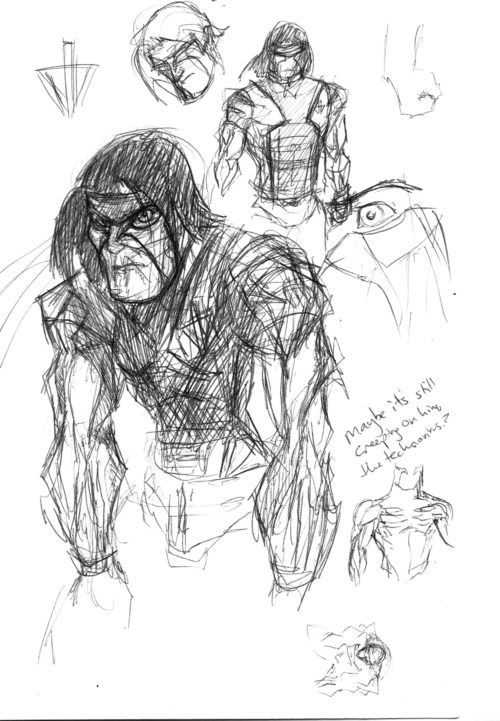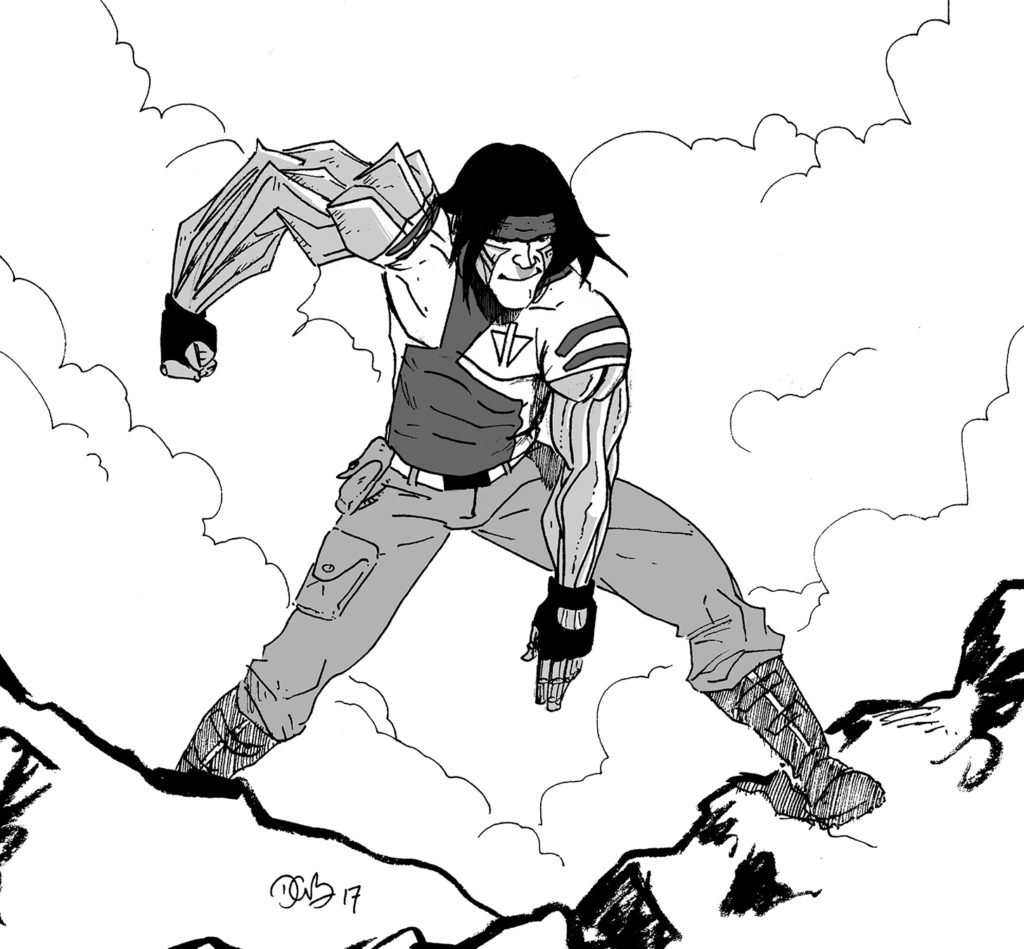Sketch Fridays #35 – Razorpoint
If we’re willing to part hairs, I’m a quarter Canadian on my father’s side. Growing up, I didn’t know anybody else that had any Canadian blood. It felt, as a white guy, kind of exotic. By the time I found the X-Men, I’ll admit that Wolverine’s Canadianness is what initially drew me to the character. A part of me also related to his anger issues, as I had severe problems as a youth and still continue to mediate.
This was also the time when Wolverine was at his height of popularity, so many Wolverine knock-offs filled the field both professionally and by fans wanting to create cool, original characters, like me at thirteen years old.
Aside from the X-Men, what marked much of my middle teenage years was a deep and devoted love of Japanese history. Not anime or manga (those were still unicorns in the world of pop culture in the mid-nineties, though anime was starting to percolate through), but history. It actually connected to my anger issues because I was introduced to it while attending martial arts classes, which was a major turning point for my anger problems. It taught me self-control and focus and letting things be. Because martial arts had such a profound effect on me, I wanted to know everything about it, especially the culture it came from.
In terms of my creative output, everything suddenly became Japanese. Lots of samurai and ninja in my sketchbooks; everybody had a katana; if time travel was involved, you can bet that a lot of time would be spent in ancient Japan.

Razorpoint in 1994.
As an original creation, Razorpoint satisfied all of these needs. He was my Wolverine. His name was Shane Yashido, a Japanese-American, whose family history I had kind of worked out going back centuries. He was the hot-head with anger issues; he was small but powerful and had claws.
As mentioned with Backfire’s post last week, the powers these characters had manifested as a consequence of being affected by a techno-organic virus of some sort that changed a part of their bodies into what is essentially a living metal. While Backfire’s head was affected, Razorpoint’s arms were transformed and, as a result, he could change his fingers into claws because, again, Wolverine is cool. Aesthetically, he was an amalgam of the X-Men’s Wolverine, WildC.A.T.s’ Grifter, and more than a hint of Cyberforce’s Ripclaw (though I wasn’t very familiar with the series). Of all of my high school creations, Razorpoint is omnipresent and goes through many iterations from the time I really got into drawing around 1994 through to almost graduating high school in 1997.

His 3 Dads: Wolverine, Grifter, Ripclaw (left to right)
What’s strange about that point is that I had no problem altering him as years went on, but, when approaching him for Sketch Friday, I found him difficult to redesign. For a second, I thought I may just pull what I did with Venture and just draw the last Razorpoint in my style and not change anything, but there were some persistent issues that bugged me enough to prevent me from doing that and actually make him into what could be a pretty neat character.

Sketches developing Razorpoint. The mask was the last thing to go.
First, the claw fingers were much too derivative to let slide, but I still wanted his name to be appropriate. Much like Backfire, the metal of his arms is rather skin-like in that it allows his arms to bend and twist as normal arms to. My first thought went to a shape-memory alloy where the thickness and shape of the metal can change to a new form and back again. Since the most metal is in the “muscle,” that would be the material that shifts, not the fingers. Based on that, it started to make sense that he could shift the metal into a blade-like structure and back again to more traditional muscle mass. If the blades are manipulations of the muscle, then it makes him even more metal (as in awesome \m/) because blades would basically extend from all over his arms instead of just at the hands, which are impractical. All he’d have to do to be deadly is, basically, spin around in a crowded room.
Thinking in terms of how cat claws work, they tend to only get revealed when the cat’s toes are fully extended; so, exposed claws are more reflex than an actual cognitive choice. This is kind of how I would like to think of Wolverine’s claws; that they only extend when throwing a punch or defending himself––when he’s tensing a set of muscles in his arms––and they aren’t mechanical, binary settings. As soon as he lets the tension out, they retract. So, I applied that idea to Razorpoint; the mass would shift if he, basically, tenses up, as if he were about to throw a punch or take one. It could also allow him to only “bladify” one arm at a time, if he wished. It would also allow him to have different “settings” depending on how his arm was positioned when he tensed up or flexed. But, in an animated sense, I love the idea of these blades covering his arms and constantly shifting and relaxing as he goes through a fight. They would work much less like claws and more like a mace––simultaneously defensive and offensive but not precise.
That was probably the biggest change to him overall. In terms of design, I kept some aspects of the original like the bars on the shoulders. Since his inception, he has always worn a full face mask with a distinctive design over the eyes. Full face masks are incredibly impractical, however, and just didn’t make sense to bring into the redesign. Instead, I modified the eye designs and put them under his actual eyes as a small manifestation of the virus and echoed the original design on his shirt instead. The setup for the metal on the face ended up becoming what drives his character in this redesign.
Shane Yashido loves having metal arms that can become bladed. He loves being a superhero. It allows him to use his martial arts training that he received while growing up with his family to its full effect. Being a Japanese-American, though, tradition doesn’t have as strong a hold on him as his elders would want. So, he’s a bit of an entitled jerk, but who believes in justice and protecting the populace. Basically, he gets to be a hero like he read in comics and saw on tv growing up.
What he doesn’t love is that, unlike Backfire, the technobiological virus seems to still be spreading. For a while it was just his arms, but it has started to creep over his chest and up his neck as well. This unknown future allows him to be the hothead; it’s fueling a kind of nihilistic attitude that causes him to jump headfirst into dangerous situations but also is a mere cover for the anxiety that plagues him day after day, wondering how far the virus will go, not knowing how it will affect him (like it has Shockwave, but we’ll get to him later). So, whereas with Backfire who is using her reaction to the virus’ manifestation to try and connect with people, Razorpoint is actively using it as a defense mechanism––much like the powers it has given him––keeping people out to protect him from acknowledging the truth.
––––––––––––
I’m not the happiest with this design; something about it still feels off to me. However, it may just be psychology. Razorpoint was the first original character I ever made and doing these Sketch Fridays kind of feels like closing the book on him (and them). Even though I probably haven’t drawn this guy since 1997, it is a little bittersweet though, just like Backfire’s redesign before him, sitting down and thinking through these characters actually gets me a little excited about the concept and I wonder, if I had the time and will, what I could properly do with them.


Discussion (2) ¬